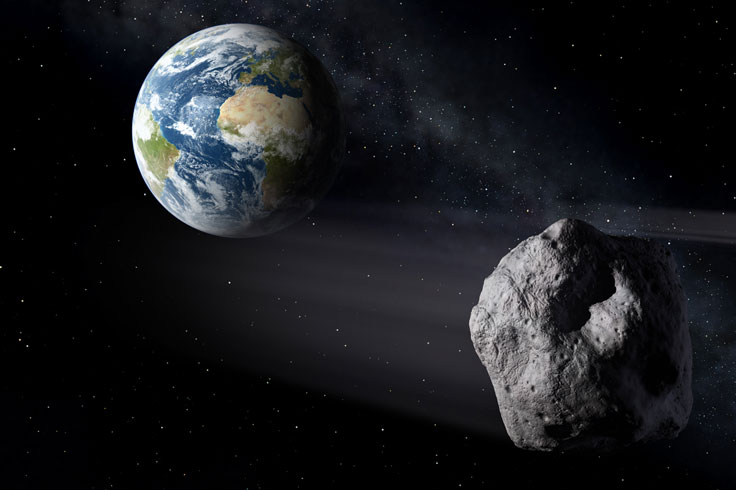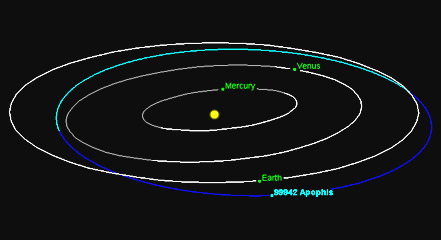The subtle effect of sunlight may turn the near-Earth asteroid Apophis toward Earth in 2068 . . . but chances for impact remain small.

NASA / JPL-Caltech
Near-Earth asteroid 99942 Apophis may crash into our planet in April 2068 after all. For the first time ever, astronomers have measured how the asteroid’s orbit is slowly shrinking. Taking this non-gravitational effect into account, “the 2068 impact scenario needs to be looked at again,” team leader David Tholen (University of Hawai‘i) told the online meeting of the Division of Planetary Sciences of the American Astronomical Society on October 26th.
Apophis was discovered in 2004. Initially, it looked like the roughly 350-meter-wide rock might crash into Earth on April 13, 2029, or maybe in April 2036. More precise observations subsequently revealed that in both cases, the chance of an actual impact is zero, although the 2029 flyby will take Apophis within the orbits of geostationary satellites — it will be visible as a fast-moving naked-eye object from Europe and Africa.

Working from the current uncertainty in the asteroid’s orbit and using just gravity, astronomers calculated that encounters later this century would also be harmless. However, in 2015, David Vokrouhlický (Charles University in Prague) and his colleagues predicted that Apophis should experience a tiny orbital change due to the Yarkovsky effect, leading to a possible impact in 2068.
The Yarkovsky effect is a subtle, net force on a small, rotating body caused by asymmetric heating. Tholen and his colleagues have now measured the strength of this effect on Apophis by making extremely precise positional observations using the Japanese 8.3-meter Subaru telescope on Mauna Kea, Hawai‘i. Their results indicate that the semi-major axis of the asteroid’s orbit is decreasing by 170 meters per year – in very good agreement with Vokrouhlický’s prediction.
The upshot: there’s indeed a small chance (currently about 1 in 150,000) of an actual impact in April 2068, a little more than 47 years from now.
“It is extremely important to recognize that warnings of a possibility of an impact are very different from predictions of impact,” says Steven Chesley (JPL). Then again, he adds that “just because some [possible impact scenarios] were eliminated in the past does not mean they will always be in the future.”
Much depends on Apophis’s “miss distance” in April 2029, and the precise way that Earth’s gravity deflects its orbit. “By studying the 2029 encounter closely and critically,” Tholen says, “it will be easier to predict future impact scenarios.”
 4
4








Comments
nancyh
October 30, 2020 at 6:28 am
Is the Yarkovsky effect taken into account with all NEOs or only those observed through certain telescopes? How many such telescopes are in use? Your article raises many questions about the reliability of PHA classification.
You must be logged in to post a comment.
Kevin Heider
November 1, 2020 at 10:03 am
The Yarkovsky effect is only useful for long-term asteroid predictions. For asteroids with short observation arcs, the Yarkovsky effect will be lost in the noise. Apophis will still have odds of impact in 2068 around 1/100000 to 1/300000. The change is trivial outside of sensational press releases.
On 12 April 2068 Apophis will probably be MORE than 1 AU (150 million km) from Earth and that is the reason the odds of impact are only 1/150000. If the asteroid was expected to be close to Earth the odds would be more on the order of 1/1000.
-- Kevin Heider
You must be logged in to post a comment.
Daniel Bamberger
March 2, 2021 at 2:10 pm
For most NEOs, the Yarkovsky effect is so small that it can not be detected, and including it in the orbit prediction makes no difference (it would not affect the uncertainty region). It becomes important only when the uncertainty region is so small that shifts of a few hundred meters per year become detectable.
Apart from a few exceptions, the effect only becomes detectable when a NEO is very well observed (i.e. for a very long time with many different telescopes), or for very small asteroids that are more affected by it. In this context, radar observations play a crucial role: "Less than 100 asteroids have significant (signal-to-noise ratio larger than 3) detections of the Yarkovsky effect; of those, only about 30 have not been observed by radar." (https://iopscience.iop.org/article/10.3847/2515-5172/aadf80/meta)
You must be logged in to post a comment.
Chuck Hards
November 3, 2020 at 1:19 pm
Hmmm... I would be 110 years old in 2068.
I'm not going to worry about Apophis at all.
You must be logged in to post a comment.
You must be logged in to post a comment.